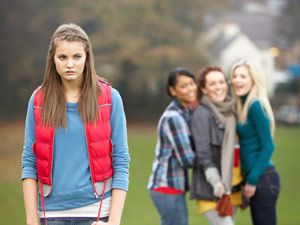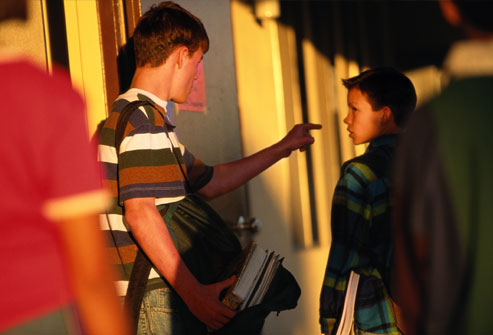Bullying can be defined in many different ways. A standard dictionary definition of the word “bully” is “the use of superior strength or influence to intimidate (someone), typically to force him or her to do what one wants.” Synonyms for the verb “bully” include: persecute, oppress, tyrannize, browbeat, harass, torment, and intimidate.
It is interesting to note that the United Kingdom has no legal definition of bullying, while some states in the United States have strict laws governing the bullying of others. Normally when the subject is discussed its reference is to incidents that occur among students in schools. Unfortunately, the school campus is not the only place where bullying occurs. It may also occur among youth in the Church.
Made to Feel as an Outcast among Peers
Bullying, which can be classified into four different types – verbal, social, physical, and cyber – is a serious problem, especially among youth. It can range from simple one-on-one bullying to more complex bullying in which the primary bully may have another person or persons to assist in his or her bullying activities.
According to the stopbullying.gov website, in order for behavior to be considered bullying it must be aggressive and include:
- An Imbalance of Power: Kids who bully use their power—such as physical strength, access to embarrassing information, or popularity—to control or harm others.
- Repetition: Bullying behaviors happen more than once or have the potential to happen more than once.
The “targets” or “victims” of bullying are often made to feel inferior to their peers. They are often the recipients of unwarranted threats (including cyber threats), the subject of malicious rumors, the objects of physical or verbal abuse (to include inappropriate sexual comments), and deliberately excluded from certain groups.
When a Supposed Safe Haven No Longer Feels Safe
Most people think of church as a safe place where children can be protected from the wiles of the world. In the minds of most people, church is the last place where they would expect anyone to be the victim of bullying, but yet it does happen.
In an LDS Living Magazine article dated 28 August 2014 titled “The Sad Truth about Bullying at Church,” Kelsey Berteaux recounts the episode of a young teenage girl who was contemplating suicide by jumping off the roof of her home because she was being bullied by the youth in her ward. In the article, Judy Wells, the mother of the young teenage girl, recalls the events that led up to her daughter wanting to commit suicide, “The girls took her journal and read it when she left it on her chair to go to the library to get a Book of Mormon. Then, when she came in, they were quoting it.” She further stated that this was only one of a hundred things those young men and young women did. She continued,
When she [her daughter] went and sat down next to some girls, the girls would get up and create a new row and leave her sitting all alone. They invented fake physical relationships she could have had with boys and teased her about them, leaving notes about it on classroom whiteboards for others to find. They even harassed her outside of church, calling her to borrow equipment for a party she wasn’t invited to, and later, calling again to say how glad they were that she wasn’t at the gathering with them.
Fortunately, Wells was able to talk her daughter down from the roof, but she found herself at a loss as to what the next steps should be in trying to help her distraught daughter.
Children and the Damaging Effects of Bullying
Kids can bully others, be bullied themselves, or witness someone else being bullied. Often kids who are involved in a bullying situation play multiple roles – they may themselves be the targets of bullying by others, or they may witness other innocent kids being bullied.
According to the stopbullying.gov website:
The roles kids play in bullying are not limited to those who bully others and those who are bullied. Some researchers talk about the “circle of bullying” to define both those directly involved in bullying and those who actively or passively assist the behavior or defend against it.
Even if a child is not directly involved in bullying, they may be contributing to the behavior. Witnessing the behavior may also affect the child, so it is important for them to learn what they should do when they see bullying happen.
Most kids play more than one role in bullying over time. In some cases, they may be directly involved in bullying as the one bullying others or being bullied and in others they may witness bullying and play an assisting or defending role. Every situation is different. Some kids are both bullied and bully others. It is important to note the multiple roles kids play, because…
- Those who are both bullied and bully others may be at more risk for negative outcomes, such as depression or suicidal ideation.
- It highlights the need to engage all kids in prevention efforts, not just those who are known to be directly involved
Addressing the Issue of Bullying in the Church
Wells eventually had her daughter attend a different ward in a different stake in an effort to keep her away from the youth who were bullying her. Unfortunately, every parent who has a son or daughter who is the victim of bullying at Church is not able to attend a different ward or stake.
The LDS Living.com article lists some ways that experts suggest can be used to recognize, prevent, and correct bullying in a church environment:
Clark Burbidge, author of the youth help series Giants in the Land, commented that “due to the more positive, value-based, and supportive overall environment of a church setting, bullying can play out in more subtle ways. We can see it in exclusive or cliquish behavior. These can also include hurtful or devaluing statements.”
The article also suggests that another form of bullying in the Church is often found in pranks that are played on unsuspecting youth during various youth activities. Judy Wells, now an advocate against bullying, made the following observation:
They’ve got to have fun out there, right? There has to be some sort of an outlet. Locking a girl in a latrine at girl’s camp, that’s okay. It’s kind of funny. She’s stuck in a smelly latrine and can’t get out until somebody comes and lets her out. But, she says, “It’s not funny.” How someone experiences a “harmless” prank can emotionally affect them for the rest of their life.
Burbidge further suggests that the process of deterring bullying behavior begins in the home. Parents have an obligation to teach their children right from wrong, and bullying other children should be at the forefront of those things that are taught as being wrong behavior. He suggests that bullying behavior can be cut off at the pass if families are doing their part to create a loving, faith-filled, family environment in the home.
Licensed family therapist, Dr. Jonathan Swinton, recommends that on the ward level, bullying can be deterred by “celebrating diversity and differences, not being judgmental, and feeling love for all of God’s children.” He further commented:
The more people appreciate the doctrines that God ‘hath made of one blood all nations of men for to dwell on the face of the earth’ (Acts 17:26), and that he ‘denieth none that come unto him, black and white, bond and free, male and female; … and all are alike unto God’ (2 Nephi 26:33), the behavior will more easily follow.
Just teaching kids to be nice will not be sufficient if they don’t really view everyone as their brothers and sisters. If they really do understand that it is their brother or sister they are doing this to, they can better show love for anyone that is different.
Wells further contends that Bishops and other Church leaders need to become actively engaged in resolving bullying issues that may occur in their wards or branches. She states that leaders should immediately alert parents of any child who is involved in a bullying situation so that they are aware of their child’s behavior towards others during church activities.
Burbidge further commented that leaders should respond to these types of situations “in a way that both supports and protects the person targeted, as well as responds in a loving but correcting way to the person responsible for the bullying. This can include counseling with both parties and their parents to provide the positive reinforcement and guidance so that alternative behaviors may be developed and replace the destructive ones.”
Every member can have an active role in ensuring that this type of behavior does not occur in his or her ward or branch by practicing charity – the pure love of Christ – towards their brothers and sisters. Every effort should be made to make everyone feel comfortable, welcome, and a part of the Church family. Each member should make the effort to be the first to offer the outstretched hand of friendship. A person may be appear different because of race, culture, or language, and they may not be known by name, but yet, they are known to us as brother and sister. When these practices are put in place, there will be no more strangers in Zion, and such adverse behaviors as bullying will cease to exist.




